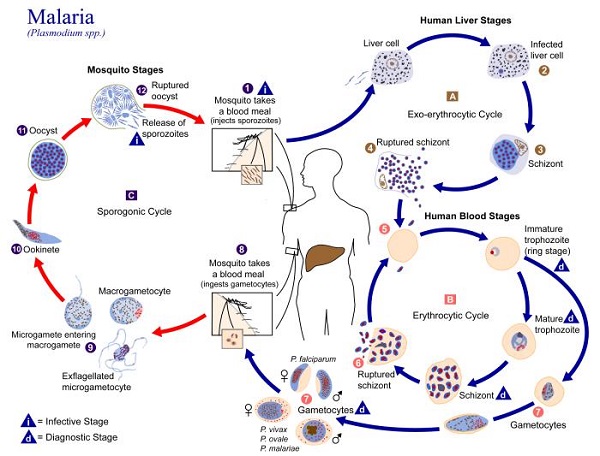Plasmodium vivax - Life Cycle, Host Immunity
Life Cycle of Plasmodium vivax
Plasmodium vivax is transmitted by the bite of a female Anopheles mosquito during a blood meal. The hypnozoites of this parasite are present in the liver parenchyma of the human host.
Human Cycle
A bite by an infected female Anopheles mosquito during the blood meal injects the Plasmodium vivax sporozoites into the capillaries of the skin
these parasitic sporozoites enter the blood circulation and within less than 30 minutes, they enter the host tissue cells
Exo-erythrocytic schizogony
after a period of seven days, the sporozoites infecting the liver cells transform into exo-erythrocytic schizonts.
the exo-erythrocytic schizonts are oval, 40μm length morphological forms that have blue-stained cytoplasm and lightly stained nucleus
each schizont may contain around 1000
the schizonts rupture to release the vast number of merozoites
some merozoites are killed by the host immune system while most invade the host erythrocytes to begin erythrocytic schizogony
some Plasmodium vivax remains in the liver cells as hypnozoites, which are responsible for relapse of the malaria disease
hypnozoites, which are a dormant form of the parasite, are 4μm to 6μm in diameter with a single nucleus
after the hypnozoites activate after a certain amount of time (may range from 6 months to 12 months), they transform into tissue schizonts within the time period of 12 to 17 days after re-infection
as a result, relapse occurs which may take place upto 3 years or more after the initial malaria infection
Erythrocytic schizogony
all stages of erythrocytic schizogony take place in the peripheral blood
the merozoites of Plasmodium vivax, released from schizonts, invade only young erythrocytes and reticulocytes but rarely infect old erythrocytes
around 2% of erythrocytes are infected by the Plasmodium vivax parasite
Once inside the erythrocytes, the merozoites develop into trophozoites and eventually into erythrocytic schizonts – all within 42 to 44 hours of the invasion
each mature erythrocytic schizont contains up to 24 or more merozoites
once the Plasmodium vivax erythrocytic schizonts rupture, the merozoites are released
these merozoites infect new erythrocytes to form erythrocytic schizonts and then into new merozoites for a few cycles
After a few cycles of merozoites to erythrocytic schizonts to merozoites, some of the merozoites develop into gametocytes- the macrogametocytes and the microgametocytes
these gametocytes take about four days to mature and more macrogametocytes are formed in number when compared to microgametocytes

Figure: Plasmodium vivax - lifecycle (Source: CDC)
Mosquito cycle
The sporogony or sexual life cycle of Plasmodium vivax takes place in the female Anopheles mosquitoes and is completed in 9 days to 10 days.
both the macrogametocytes and microgametocytes are ingested by the female Anopheles mosquito during a blood meal from infected humans
after reaching the mid-gut (stomach) of the mosquito, the male gametocyte (microgametocyte) undergoes exflagellation, which is the transformation by rapid division
exflagellation involves microgametocytes becoming extra cellular followed by repeated division of nuclei within 10-12 minutes to form 6-8 daughter nuclei
eventually, each nuclei becomes surrounded by a developing axoneme
finally, the microgametocyte rupture to release 6-8 daughter nuclei- with each nuclei containing an axoneme bud which later becomes microgametes
these Plasmodium vivax microgametes are highly motile sperm-like organisms with a single flagella
the female gametocyte (macrogametocyte) matures by a single process of nuclear reduction and extension of polar bodies
each macrogametocyte can only give rise to only one macrogamete
the male gametocyte nucleus fuses with the female gametocyte nucleus through the process of fertilization and a zygote is produced
the zygote is formed within 20 to 120 minutes from the blood meal by the vector mosquito
the zygote then lengthens and extends to form a motile ookinete which is more slender in Plasmodium vivax than in other Plasmodium spp
these ookinetes penetrate the gut wall of the mosquito host, secrets a thin wall, and grow into a sphere (6μm to 12 μm in diameter) which is termed an oocyst
the oocyst contains a number of sporoblasts (haploid nucleated masses)
these sporoblasts then divide repeatedly to form sporozoites which are in turn released into the hemocele of the mosquito after rupturing of oocyst – the process called sporogony
the Plasmodium vivax sporozoites, which are infectious to humans, migrate to the salivary glands
sporozoites are injected into the human host when the mosquito takes a blood meal from a healthy human and the life cycle of Plasmodium vivax is continued
Host Immunity of Plasmodium vivax
Haemoglobin E provides natural protection against Plasmodium vivax
Pathogenesis and infection of Plasmodium vivax depend on the ability of merozoites to attach to specific receptors present on the surface of erythrocytes. These receptor sites are called Duffy sites and people who genetically possess them are called Duffy blood group and Duffy-positive persons. The Duffy blood group expresses two alleles called Fya and Fyb which are glycoprotein receptors.
The Duffy negative people are most common in Africa. Since they lack the Fya and Fyb receptors in their erythrocytes, the merozoites cannot invade the RBCs and cause malaria.